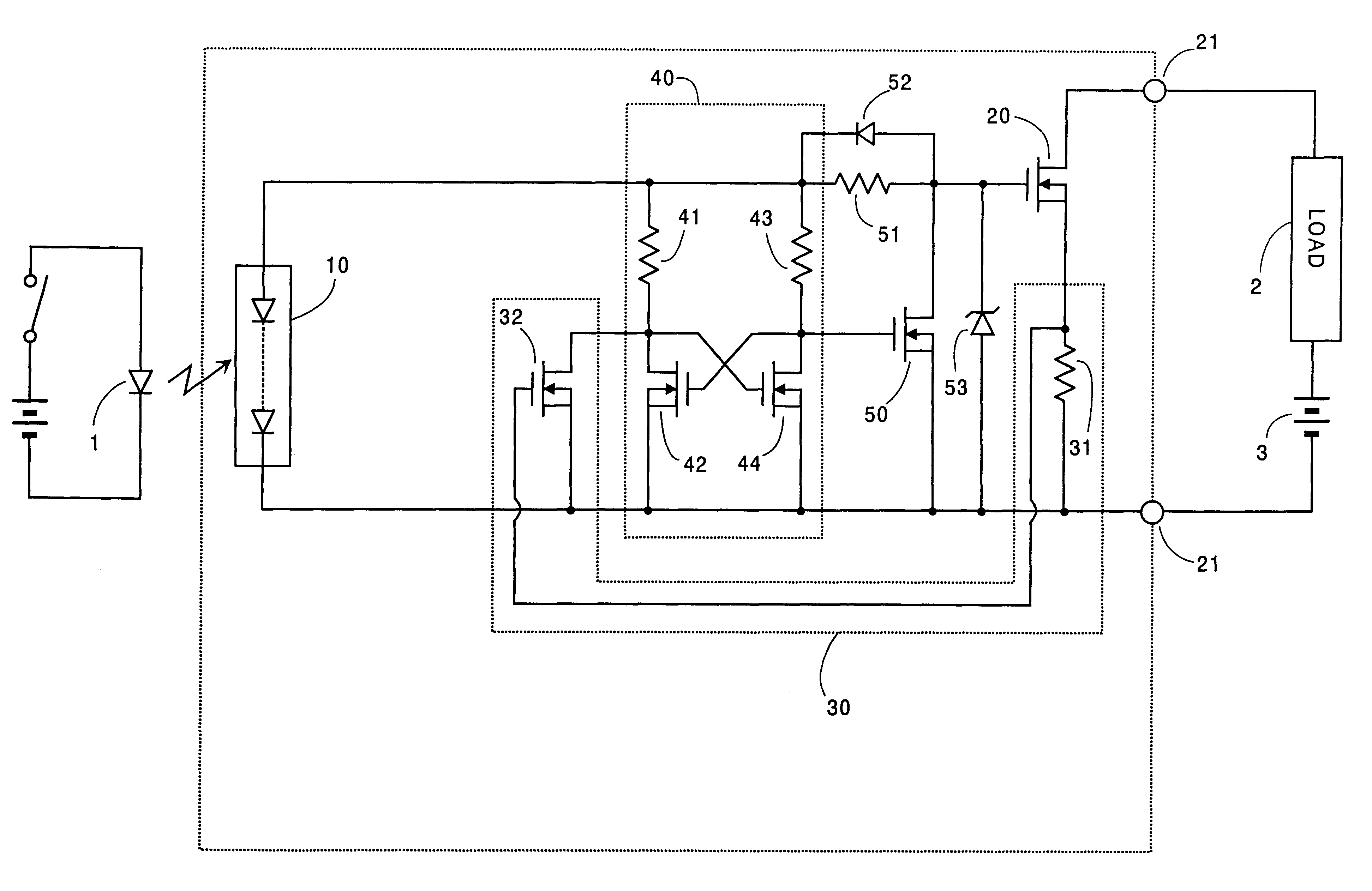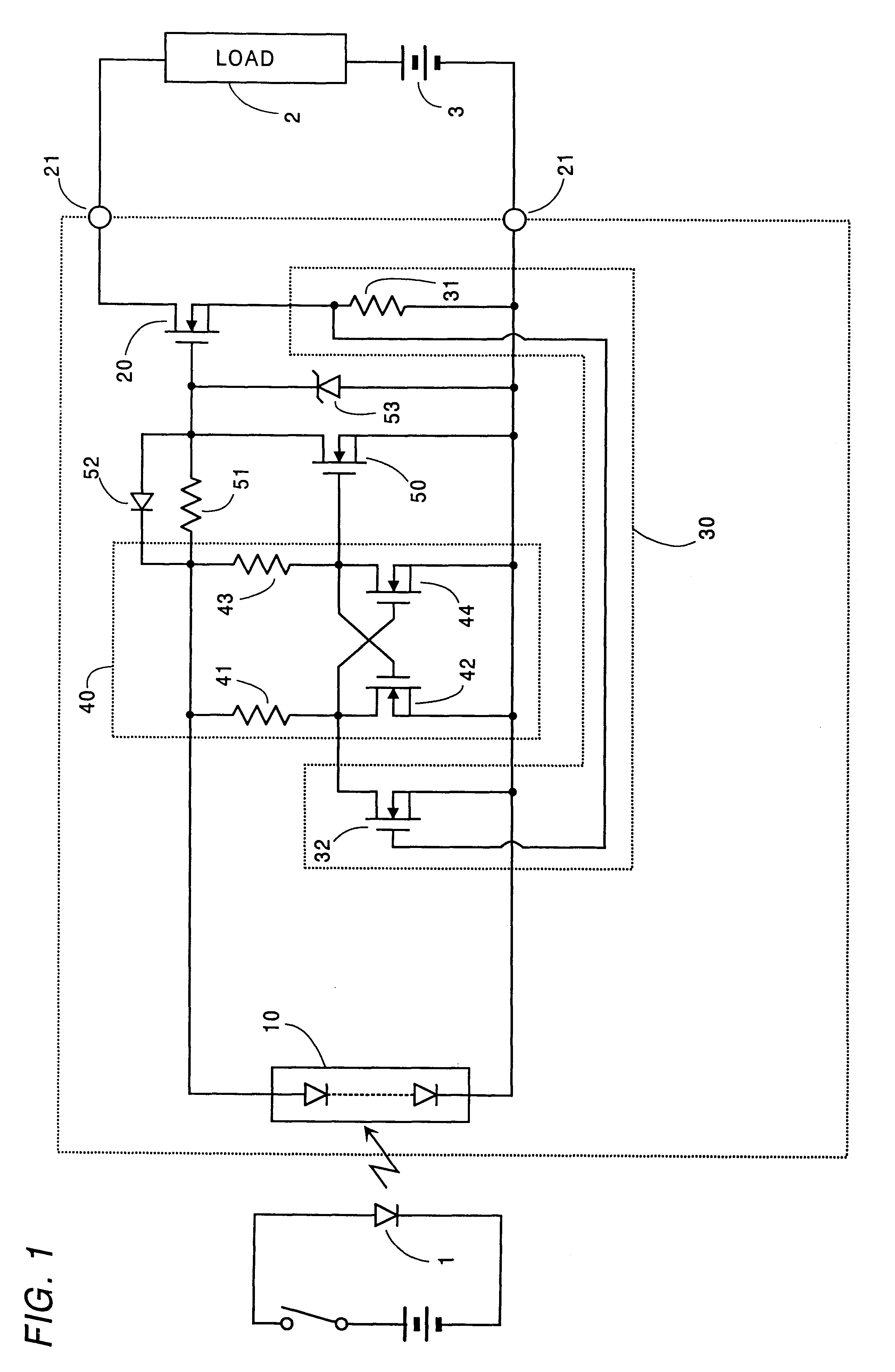Light responsive semiconductor switch with shorted load protection
a technology of shorted load protection and semiconductor switch, which is applied in the direction of semiconductor/solid-state device details, pulse technique, radiation control devices, etc., can solve the problems of not being able to protect the load circuit as well as the output switching transistor, and it is difficult to combine the two requirements against the use of photovoltaic elements of varying current generation capacity
- Summary
- Abstract
- Description
- Claims
- Application Information
AI Technical Summary
Benefits of technology
Problems solved by technology
Method used
Image
Examples
first embodiment
Referring now to FIG. 1, there is shown a light responsive semiconductor switch in accordance with a first embodiment of the present invention. The switch is utilized in combination with a light emitting diode 1 to constitute an optical relay for connecting and disconnecting a load 2 to and from its power source 3. The switch includes a photovoltaic element 10 in the form of a photo-diode array which generates an electric power upon absorption of a light from the light emitting diode 1. The electric power gives an operating voltage which decreases with an increasing current from the photo-diode array 10. The operating voltage is applied to trigger an output switching transistor 20 in the form of an n-channel enhancement metal oxide field-effect transistor (MOSFET) whose gate-source is connected across the photo-diode array 10. The output MOSFET 20 has a drain and a source connected respectively to output terminals 21 which are adapted in use for connection with a load circuit compos...
second embodiment
Referring to FIG. 4, there is shown a light responsive semiconductor switch in accordance with a second embodiment of the present invention. The switch of this embodiment is designed for a load circuit of energizing the load 2 with an AC power source 3A, and is identical to the first embodiment except for the use of an additional output MOSFET 22 and for the inclusion of an additional current sensing resistor 33, and an additional sensor MOSFET 34 in the overcurrent sensor 30A. Like elements are designated by like reference numerals with a suffix letter of "A". The additional output MOSFET 22 is connected in series with the output MOSFET 20A between the output terminals 21A with the sources of MOSFETs 20A and 22 being connected to each other and with the gates of MOSFETs 20A and 22 being commonly connected to receive the operating voltage from the photo-diode array 10A. The additional resistor 33 is connected in series with resistor 31A between the output terminals 21A to provide a ...
third embodiment
Referring to FIG. 7, there is shown a light responsive semiconductor switch in accordance with a third embodiment of the present invention which is identical to the first embodiment except for the inclusion of a bypass MOSFET 35 in the overcurrent sensor 30D. Like elements are designated by like reference numerals with a suffix letter of "D". The bypass MOSFET 35 has its source-drain connected in series with the current sensing resistor 31D across the drain-source of the output MOSFET 20D, and has its gate to the gate of the output MOSFET 20D to commonly receive the operating voltage from the photo-diode array 10D. The bypass MOSFET 35 and the resistor 31D form a high resistance path across the output MOSFET 20D to flow a fraction of the load current through the resistor 31D merely for detection of the overcurrent, allowing to flow the substantial load current through the output MOSFET 20D. When the overcurrent sensor 30D detects the overcurrent, the latch circuit 40D responds to ke...
PUM
 Login to View More
Login to View More Abstract
Description
Claims
Application Information
 Login to View More
Login to View More - R&D
- Intellectual Property
- Life Sciences
- Materials
- Tech Scout
- Unparalleled Data Quality
- Higher Quality Content
- 60% Fewer Hallucinations
Browse by: Latest US Patents, China's latest patents, Technical Efficacy Thesaurus, Application Domain, Technology Topic, Popular Technical Reports.
© 2025 PatSnap. All rights reserved.Legal|Privacy policy|Modern Slavery Act Transparency Statement|Sitemap|About US| Contact US: help@patsnap.com



